London
Gallery 2
(Regent's
Park Canal)
London, we
know, is a massive resource for public
lettering from times past. We include here one of several galleries of
lettering images to give a hint of these riches. If you have any
information about any of the signs, do email
us.
These images come from a walk from The Angel round to the Olympic Park,
along the Regent's Park Canal.
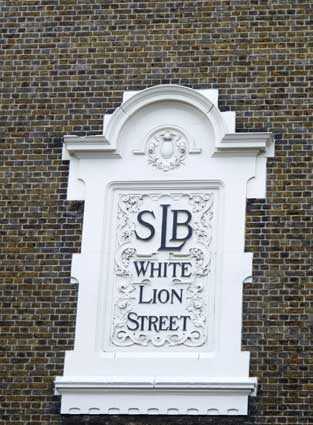 All
photographs courtesy David Gaylard
All
photographs courtesy David Gaylard
'SLB
WHITE
LION
STREET'
This fine
piece of relief work is well preserved and
lettered, although to push the downstroke of the 'L' to the centre
line, there's an uncomfortable space between it and the preceding 'S'
– not to mention a crush with the following 'B'. This plaque
is
on the wall of New River College. The letters 'LSB' stand for London
School Board, the education authority which erected the building as
White Lion Street School. The college took its name from the New River,
a 17th century artificial 'river' which carried drinking water 20 miles
from the River Lee and Amwell Springs in Hertfordshire to reservoirs in
Islington. One of these reservoirs stands in nearby Claremont Square
and in 2009 was still in use by Thames Water.
We have come across this write-up (published 1 June, 2012): 'Acrobats from Archway
theatre group
Scarabeus scaled the walls of the former White Lion Youth Centre at the
weekend to help mark its transformation into a state-of-the-art youth
“hub”. The Lift, in White Lion Street, Angel, has a
gym,
professional kitchen, dance and exercise studios, café and a
roof garden.'
 All
images 2012
All
images 2012
'THOS
BRIGGS (LONDON)
LTD'
This
central curved panel could be a challenge to the
letterer, but they've made a fair fist of the capitals of varying
heights, superior 'S' and 'TD' and small bracketted
'(London)'.
This Victorian factory in Southgate Road, Islington now seems to be wholly residential.
There is a similar lettered rectangular panel high on the wall
overlooking the canal. Thomas Briggs were tentmakers who supplied the
British Army.
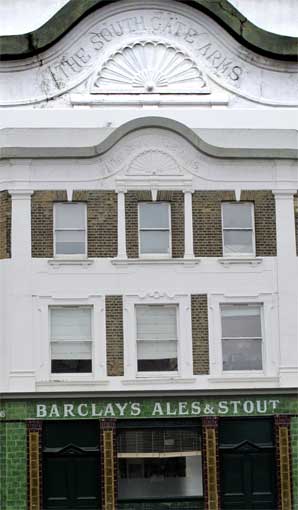
'THE
SOUTH GATE ARMS
BARCLAY'S ALES & STOUT'
A
closed-down public house at 1
Southgate Road, N1. The nicely tiled ground floor surround continues to
the left and round the corner with the brewery name repeated and 'The
Southgate Arms' over the corner door. Pedants' corner: in the upper
curved lettering, there is a gap between the words 'South' and 'Gate'
(unlike the name of the road and the suburb in north London),
however the tiled name on the corner is 'Southgate'; also a nicely
placed posessive apostrophe after 'Barclay'.
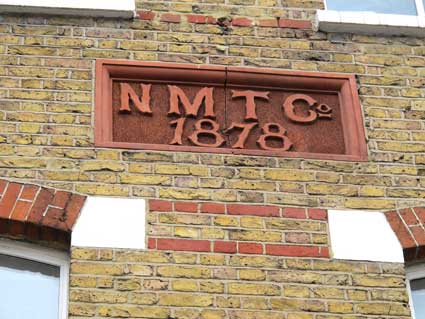
'NMTCO
1878'
NMTCo.
stands for North Metropolitan Tramways Company.
This is the original dwelling house above the cart entrance. The site
was built in 1878 as a forage warehouse for the company's horses. It
was later used as a spice warehouse. Listed building information
describes this as probably the most distinctive relic of 19th century
horse tramway system of London. In 2012 expensive flats are behind it,
overlooking the canal basin.
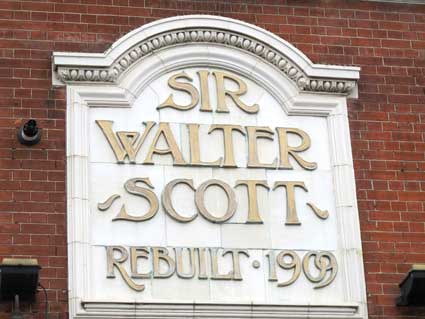
'SIR
WALTER
-SCOTT-
REBUILT .
1909'
This
large-scale plaque sits in the centre of a corner
public house now called variously The Market Cafe or La Vie En Rose,
Broadway Market alongside the Regent's Park Canal, Hackney. This pub
was in existence by 1851 and was rebuilt in its present form in
1909. It was tied to the Whitbread Brewery and closed in 1999
for
conversion to restaurant use. Sir Walter Scott was a popular Scottish
historical novelist, playwright, and poet who died in 1832. What
strikes the observer is the flamboyant style of character form and
spacing employed here: gold letters picked out against white stone with
a curved pediment into which the 'Sir' securely fits. Serifs are
stretched and curled; that uninhibited 'W' and the very high horizontal
of the 'E' are striking along with the kern of the 'R' of 'Rebuilt' and
the interlinking '0' and '9'. Wonderful.
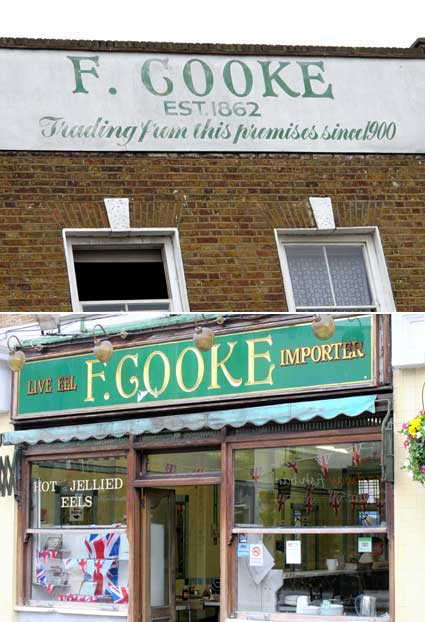
'F.
COOKE
EST. 1862
Trading from this premises since 1900'
'F. COOKE
LIVE EEL
... IMPORTER'
From the
Waverley novels to jellied eels. Fred Cooke
started selling jellied eels on Broadway Market in 1900. His restaurant
served shepherds driving their flocks to the City of London. By the
2012 jubilee, Mr Cooke's grandson, clearly a patriot, continued the
same trade from these premises.
Perhaps unique on this website, this piece of lettering (albeit modern,
but on an historic vehicle) moves about.
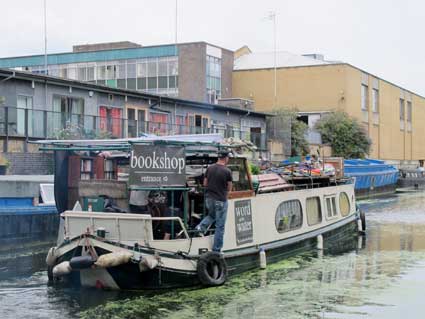
'bookshop
entrance>'
'words
on the
water
The London
Bookbarge'
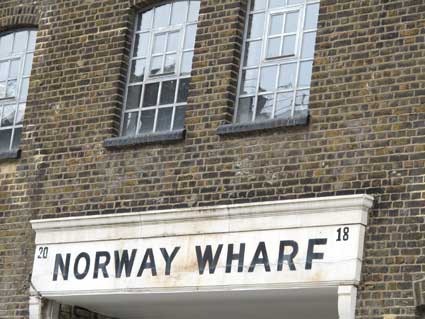
'20
NORWAY WHARF 18'
This
lettering runs over an unpreposessing pair of gates in
Hertford Road, N1.

RON'S
EEL AND SHELL FISH
WHELKS
PRAWNS SMOKED HADDOCK ROLL MOPS
SEA FOOD PIECES
SMOKED SALMON
EVERY FRIDAY AND SATURDAY
HOXTON STREET MARKET
SHOP LOCAL'
An
advertisement for Ron's Eel and Shell Fish (definitely not 'shellfish')
on the Hackney stretch of Regent's Canal. A triumph of inter-character
and inter-word spacing which we feel here is justified (haw).

'OLD
FORD
LOCK'
A footway plate in Hackney
Wick. The helpful heritage information plaque nearby tells us that the
Regent's Park Canal runs from Limehouse to join the Grand Junction
Canal at Paddington and it opened in 1820. The area, Old Ford, is named
after the natural ford which used to exist in the area crossing the
uncanalised River Lea. Old Ford Lock marks the start of the Hackney Cut
– an artificial channel built in the 18th century to cut off
a large loop in the natural channel. The natural river rejoins the
Navigation at this point.
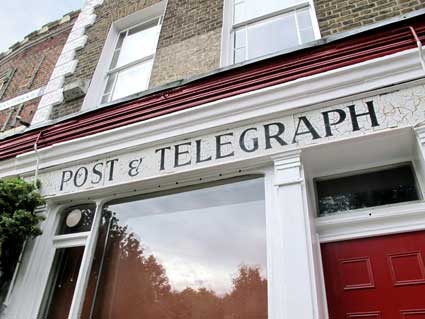
'POST
& TELEGRAPH'
Seen
over a former shop-front in Wansbeck Road, Hackney, E3 right by the
elevated A12. We wonder if this is a now-defunct post
office, as we can't trace a publication of this name. The phrase 'Post
& Telegraph' was used
to promote these neighborhood GPO offices.
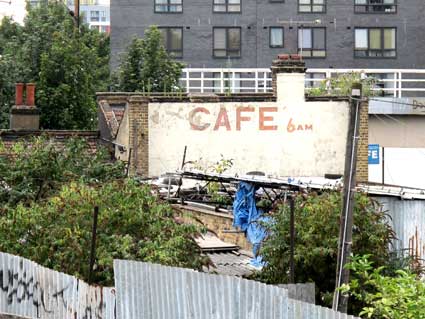
'CAFE
6AM'
Our
contributor: "The last image, behind Hackney Wick,
gives I think a true picture of the rejuvenation of the East End,
courtesy of LOCOG." It will be interesting to see if anyone recalls the
meaning of this last acronym in years to come.
For further examples see our London Galleries page.
 All
photographs courtesy David Gaylard
All
photographs courtesy David Gaylard All
images 2012
All
images 2012








